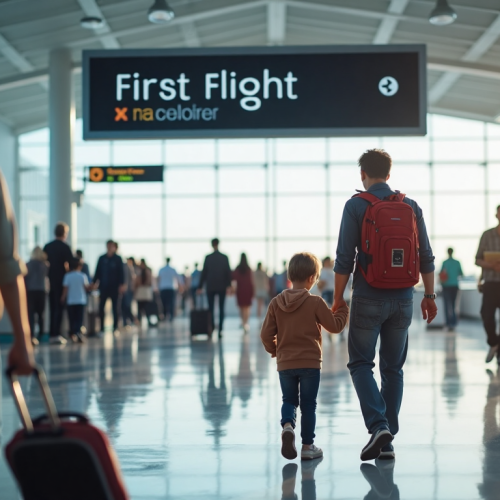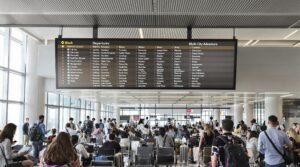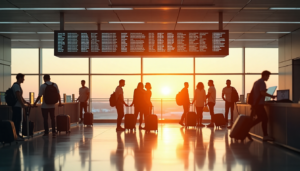Stepping into an airport for your very first flight can feel both thrilling and chaotic all at once. It’s easy to assume the toughest part is finding your way through busy terminals, but here’s the catch. The simple act of arriving at least two hours before a domestic flight or three hours for an international flight can be the single biggest stress reducer according to travel experts. Most first-time flyers miss this, rushing in at the last minute and piling on anxiety. Knowing this small timing trick flips the whole experience from overwhelming to refreshingly manageable—there’s much more peace of mind up for grabs than you might expect.
Table of Contents
- Preparing For Your First Flight Experience
- What To Expect At The Airport And Onboard
- Saving Time And Money While Traveling
- Pro Traveler Hacks For Stress-Free Journeys
Quick Summary
| Takeaway | Explanation |
|---|---|
| Arrive Early | Arrive at least two hours before domestic flights and three hours for international flights to allow time for check-in and security screening. |
| Prepare for Security | Wear easily removable shoes and minimize metal accessories to facilitate a smoother screening process, keeping essential items readily accessible in your carry-on. |
| Utilize Online Check-In | Take advantage of online check-in 24 hours before your flight to select seats and obtain digital boarding passes, helping you bypass lengthy lines at the airport. |
| Pack Light | To avoid baggage fees, consider using a carry-on bag and packing versatile clothing that can be mixed and matched. |
| Manage Travel Stress | Practice deep breathing exercises before and during your journey to manage anxiety, and stay hydrated to combat the physical stress of flying. |
Preparing for Your First Flight Experience
Taking your first flight can feel like navigating an entirely new world. The airport environment, security procedures, and flight protocols can seem overwhelming for novice travelers. However, with the right preparation and mindset, you can transform this potentially stressful experience into a smooth and enjoyable journey.
Understanding Airport Logistics and Check-In Procedures
The key to a successful first flight starts with understanding the airport logistics. According to the Transportation Security Administration, travelers should arrive at least two hours before domestic flights and three hours before international flights. This extra time allows for unexpected delays during security screening, check-in processes, and potential navigation challenges.
Before leaving home, double-check your travel documents. Ensure your identification is current and matches your ticket exactly. For domestic flights, a valid state driver’s license or government-issued ID works. International travelers need a passport that’s valid for at least six months beyond their travel dates.
Health and Safety Preparation
Preparing for your flight isn’t just about logistics it’s also about personal health and comfort. The Centers for Disease Control and Prevention recommends consulting with a healthcare provider 4-6 weeks before departure. This consultation can help you understand any destination-specific health requirements, recommended vaccinations, and potential travel health precautions.
Physical preparation is equally important. Stay hydrated before and during your flight, wear comfortable clothing, and consider compression socks for longer journeys. Pack essential medications in your carry-on, and if you have specific health concerns, inform the airline in advance.
Navigating Security and Onboard Etiquette
Security screening can be intimidating for first-time flyers. The Federal Aviation Administration advises paying close attention to the flight attendant safety briefing and carefully reviewing the safety briefing card. These instructions are crucial for understanding emergency procedures and basic flight protocols.
When going through security, prepare in advance. Wear easily removable shoes, minimize metal accessories, and have your electronics and liquids readily accessible for quick screening. Pack your carry-on strategically: keep essential items like medications, chargers, and a change of clothes within easy reach.
Your first flight is an exciting milestone in your travel journey. By understanding these key preparation steps, you can approach your travel with confidence and minimize potential stress. Remember, every seasoned traveler was once a first-time flyer. With proper preparation and a calm mindset, you’ll be well on your way to enjoying your aerial adventure.
Learn more about smart travel planning for your upcoming journey.
What to Expect at the Airport and Onboard
Flying for the first time involves navigating a complex series of steps and procedures that might seem intimidating. Understanding the typical airport and onboard experience can significantly reduce anxiety and help you feel more confident during your journey.
Airport Navigation and Check-In Process
The airport experience begins before you even reach the terminal. According to Eton College’s Travel Guide, utilizing online check-in can dramatically simplify your airport experience. Most airlines offer online check-in 24 hours before departure, allowing you to select seats, obtain digital boarding passes, and bypass lengthy check-in counters.
Once you arrive at the airport, follow the signs to your airline’s check-in area. If you have checked baggage, you’ll need to visit the airline’s counter. Have your identification and reservation details readily available. Some airports offer self-service kiosks that can expedite the check-in process, making it more convenient for first-time travelers.
Security Screening and Boarding Procedures
Security screening is a critical part of the airport experience. As recommended by Simple Flying’s Beginner’s Guide, prepare for security by organizing your carry-on items. You’ll need to remove laptops, tablets, large electronic devices, and liquids from your bag. Wear slip-on shoes and minimal jewelry to speed up the screening process.
Be prepared to place your carry-on bags and personal items in separate bins for x-ray scanning. Remove your jacket and empty your pockets. Follow the instructions of security personnel carefully. If you have any medical devices or special circumstances, inform the staff in advance to ensure a smooth screening process.
Onboard Experience and Passenger Etiquette
Once you board the aircraft, locate your assigned seat using the boarding pass. Overhead compartments are typically used for carry-on luggage, while smaller personal items can be stored under the seat in front of you. Pay attention to the flight attendants’ safety demonstration, even if you’ve heard it before. These instructions are crucial in emergency situations.
During the flight, maintain considerate behavior towards fellow passengers. Use headphones when listening to music or watching videos, keep your voice low during conversations, and be mindful of personal space. If you’re prone to motion sickness, consider selecting a seat over the wing, where movement is less pronounced, and bring appropriate medication.
Stay hydrated during the flight, but be mindful of alcohol consumption. The pressurized cabin environment can amplify the effects of alcohol and cause quicker dehydration. Use the in-flight entertainment system, read a book, or take a nap to make your flight more enjoyable.
Discover smart travel tips for your next adventure.
Saving Time and Money While Traveling
Traveling doesn’t have to drain your bank account. Smart planning and strategic choices can help first-time flyers maximize their budget and minimize unnecessary expenses. Understanding the nuances of budget travel can transform your journey from financially stressful to economically savvy.
Strategic Flight Booking Techniques
Timing is everything when it comes to affordable travel. According to Money Magazine, traveling on Tuesdays and Wednesdays can save an average of 17% on domestic airfare, which translates to approximately $50 per ticket. This seemingly small adjustment can make a significant difference in your travel budget.
Booking in advance is another critical strategy. Financial experts recommend booking domestic flights 1-3 months ahead and international trips 2-6 months before departure. These windows typically offer the most competitive pricing. Use price comparison websites, set up fare alerts, and be flexible with your travel dates to secure the best deals.
Below is a table summarizing key strategies and estimated savings for timing your flight bookings based on information in this section:
| Strategy | Recommended Action | Estimated Savings |
|---|---|---|
| Book on Tuesdays/Wednesdays | Fly midweek | Up to 17% (~$50) per ticket |
| Book in Advance (Domestic) | 1-3 months before departure | Most competitive fares |
| Book in Advance (International) | 2-6 months before departure | Most competitive fares |
| Use Fare Alerts/Comparison Sites | Set up alerts, compare prices | Maximize potential deals |
Minimizing Additional Travel Expenses
Baggage fees can quickly escalate your travel costs. Travel financial advisors suggest packing light and understanding airline baggage policies. Many airlines charge substantial fees for checked bags, so consider the following strategies:
- Pack versatile clothing that can be mixed and matched
- Use a carry-on bag to avoid checked baggage fees
- Roll clothes instead of folding to maximize space
- Wear bulky items like jackets during travel to save luggage space
Smart Spending and Saving Strategies
Beyond flight and baggage considerations, smart travelers look for comprehensive ways to reduce expenses. Consider signing up for airline loyalty programs, which can offer free miles, priority boarding, and occasional upgrades. Credit cards with travel rewards can also provide significant savings through point accumulation and travel-related perks.
Additionally, be strategic about additional travel expenses. Pack your own snacks to avoid expensive airport food, bring an empty water bottle to fill after security, and research budget-friendly transportation options at your destination. Small savings can accumulate quickly, giving you more financial flexibility during your trip.
Below is a checklist of practical money-saving tips mentioned in this section to help you minimize common expenses as a first-time flyer:
| Money-Saving Tip | Benefit/Status |
|---|---|
| Pack your own snacks | Avoid expensive airport food |
| Bring empty water bottle | Save on drinks after security |
| Use carry-on to avoid baggage fees | Reduce total travel cost |
| Enroll in airline loyalty programs | Earn miles & perks |
| Use travel rewards credit cards | Redeem points & save |
| Research local transport options | Find budget-friendly travel |
Discover comprehensive budget travel strategies that can help you make the most of your travel budget without compromising on experience. Remember, smart spending is about making informed choices, not restricting your enjoyment.
Pro Traveler Hacks for Stress-Free Journeys
Traveling can be overwhelming, especially for first-time flyers. Seasoned travelers have developed numerous strategies to transform potentially stressful journeys into smooth, enjoyable experiences. By implementing these professional travel hacks, you can navigate your flight with confidence and ease.
Mental and Physical Preparation Techniques
Managing travel anxiety begins before you even reach the airport. According to Wowfare’s Travel Experts, deep breathing exercises can significantly reduce stress. Practice a simple technique: inhale for four counts, hold for four, and exhale for six. This method helps lower heart rate and calm nerves during potentially anxious moments.
Staying hydrated is another critical component of stress management. Associated Press Travel Health Experts recommend bringing an empty water bottle to fill after security. Proper hydration helps regulate body temperature, supports cognitive function, and reduces the physical stress of flying. Additionally, apply moisturizer before and during the flight to combat the dry cabin air and maintain skin health.
Strategic Seating and Comfort Optimization
Consumer Reports Travel Specialists suggest that seat selection can dramatically impact your travel experience. Choose seats away from high-traffic areas like galleys and restrooms to minimize disturbances. If you’re prone to motion sickness, seats over the wing typically experience less turbulence.
Pack a personal comfort kit with essential items: noise-canceling headphones, a neck pillow, eye mask, compression socks, and layers of comfortable clothing. These items can transform a potentially uncomfortable journey into a more relaxing experience. Consider compression socks to improve circulation during long flights and prevent potential swelling.
Technology and Communication Strategies
Leverage technology to reduce travel stress. Download your airline’s mobile app for real-time flight updates, digital boarding passes, and quick communication channels. Enable notifications to stay informed about gate changes, delays, or boarding times. Many apps now offer interactive airport maps to help you navigate unfamiliar terminals.
Prepare your devices for the journey. Download entertainment, podcasts, or work materials before the flight. Bring portable chargers and necessary adapters, and consider downloading offline maps of your destination. Communication is key traveler knowledge that can prevent unnecessary stress.
Explore more smart travel companion tips to enhance your journey and minimize potential travel challenges. Remember, the most successful travelers are those who prepare, stay flexible, and maintain a positive attitude.
Frequently Asked Questions
What should first-time flyers do to prepare for their flight?
First-time flyers should arrive at the airport at least two hours before domestic flights and three hours for international flights. This early arrival allows time for check-in, security screening, and airport navigation, reducing stress.
How can I make the security screening process easier as a first-time flyer?
To ease the security process, wear easily removable shoes, minimize metal accessories, and pack your carry-on strategically. Keep essential items like medications and electronics readily accessible to speed up screening.
What are some packing tips for first-time flyers?
Pack light by using a carry-on bag and bringing versatile clothing that can be mixed and matched. Rolling clothes instead of folding them can save space, and wearing bulky items like jackets can also help limit luggage weight.
How can I manage anxiety while flying?
To manage anxiety, practice deep breathing exercises before and during the journey, stay hydrated, and consider bringing items for comfort, like noise-canceling headphones or a neck pillow. Preparing mentally and physically can help create a more enjoyable flying experience.
Ready for Takeoff Without the Stress? Discover the VacationSpotter Advantage
Feeling nervous about navigating busy airports, booking the right flight, or trying to find the best deals as a first-time flyer? You are not alone. Many beginners delay booking or overspend because the world of air travel seems overwhelming. This article has shown you that arriving early, preparing for security, and booking smart can give you peace of mind. Now, imagine if all that planning could be made simple, fast, and tailored just for you.
Unlock worry-free travel by letting VacationSpotter.com handle your flight, hotel, and transfer bookings in one place. Compare the best options within seconds and enjoy insider savings that first-time flyers often miss. Take control of your journey now so you can focus on making amazing memories instead of stressing over logistics. Book your perfect trip today and feel the difference from your very first flight.
Recommended Articles
- How Early to Book Flights in 2025: Save More & Travel Smart – Vacationspotter.com
- How Flight Prices Change: Smart Ways to Save in 2025 – Vacationspotter.com
- Top Tips for Road Trips in 2025: Save, Explore, Enjoy – Vacationspotter.com
- How Travel Booking Works: The 2025 Guide for Travel Lovers – Vacationspotter.com
- Travel Itinerary Planning Made Easy: Smart Tips for 2025 Adventures – Vacationspotter.com
- Top Tips for Solo Travelers: Smart and Safe Adventures 2025 – Vacationspotter.com








